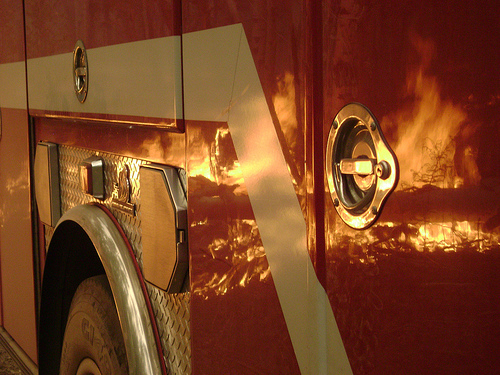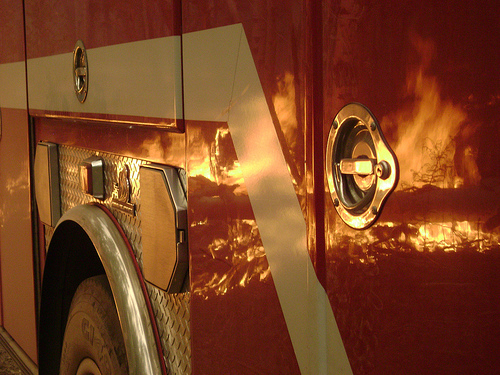 A fire engine near near Nutrioso, Ariz. Photo: U.S. Forest Service, Apache-Sitgreaves National ForestsOne of the least controversial impacts of the climate crisis is more frequent, severe, and damaging wildfires in America’s West. Why won’t reporters say so?
A fire engine near near Nutrioso, Ariz. Photo: U.S. Forest Service, Apache-Sitgreaves National ForestsOne of the least controversial impacts of the climate crisis is more frequent, severe, and damaging wildfires in America’s West. Why won’t reporters say so?
It’s been a scary spring for wildfires in places like Arizona, New Mexico, and Texas. Global warming caused by human-made carbon pollution is fueling perfect conditions, with longer fire seasons, drier conditions, and more lightning strikes.
But a search of Google News over the last week shows few reporters are connecting the dots for their readers. I did a search for stories that mentioned both wildfires and climate or global warming. I found very few stories in mainstream news outlets that mentioned climate and wildfires together at all, and the ones that did were just as likely to wrongly downplay the connection as correctly draw the scientifically documented tie. (Note that Google News is a crude tool, not covering every print outlet and including very little of what’s said on TV and radio. If you know a story I missed, please add it in comments.)
First, the outlets that made the right scientific connection between wildfires and global warming:
- ABC News directly connects global warming and extreme weather.
- Public Radio International doesn’t just connect carbon pollution and changes in weather patterns — it asks if enough is being done to prepare communities for future disasters.
- NPR’s Science Friday had as a guest Joel Achenbach, who recently predicted that the 2100s will be the Century of Disasters.
- Reuters asks if the insurance industry can survive the new era.
That’s it. Four stories that accurately connected wildfires and global warming based on the best science available. That’s all I could find.
Now for the stories that mentioned climate and wildfires but failed to correctly connect the dots:
- PBS downplays the link by quoting AccuWeather, which until recently employed climate science denier Joe Bastardi.
- USA Today baldly states its disinterest in delving into any link, saying, “Never mind the debate over global warming, its possible causes and effects.”
- A New York Times/Greenwire article ignores the evidence supporting a link, instead going into extensive detail on what we don’t know. (Joseph Romm analyzes this article in more depth at Climate Progress.)
- The Arizona Republic makes only a passing reference to the climate link while making the wildfires sound strictly like a forest management issue.
CNN.com didn’t connect climate and wildfires in America that I could see. However, it does have story noting that thanks to global warming, Siberia, once frozen, is now on fire.
What’s so strange about reporters’ reticence is that the connection between global warming and wildfires isn’t controversial in the climate science community. While scientists are always eager to learn more and shine light in every possible corner, the basics are straightforward and established: More heat + more droughts = more wildfires. Don’t believe me? Ask NASA. Or the Environmental Protection Agency.
How established? Amanda Staudt, the National Wildlife Federation’s climate scientist, made this video on the climate-wildfire connection a full three years ago:
So why doesn’t the line get drawn? Polluter-funded front groups and their allies in the media stand ready to attack anyone who reports scientific fact on climate change. For both reporters and the government officials they’re quoting, it takes courage to stand up to that.
Most ironic about the New York Times/Greenwire article: Just last week, the Times‘ Leslie Kaufman wrote this about a recent climate poll:
Scientists at the National Atmospheric and Oceanic Administration [NOAA] drew a relatively high approval rating, with 76 percent of respondents saying they strongly or somewhat trusted them.
Of course, the agency states unequivocally that the earth is warming and that human activity is a leading cause. So if 76 percent of the American public trusts NOAA scientists strongly or somewhat, why don’t more people accept their conclusions?
NOAA wrote about “Climate Enhanced Wildfires” … in 1998. But here we are 13 years later and The New York Times is still reporting to the controversy on the climate-wildfires link. Is it any wonder some Americans are still uncertain?
To learn more about the connection between global warming and extreme weather, visit the National Wildlife Federation.


